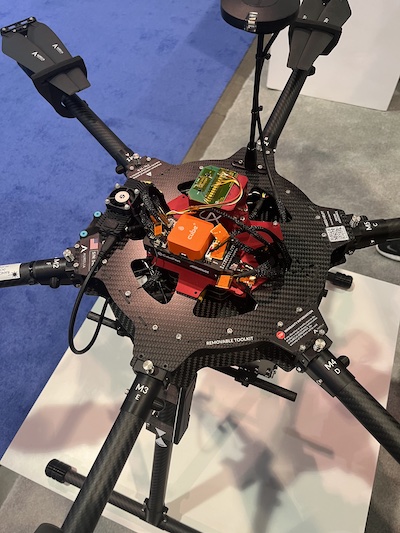Throughout CES 2024, 4,300+ exhibitors and 135,000+ attendees from the global tech industry came together for major announcements, product launches and the opportunity to collaborate on and be inspired by the tech creating a better tomorrow. Among those products, the just-launched ANELLO X3, a small but mighty inertial measurement unit (IMU) from ANELLO Photonics, stood tall as a game-changer for a wide range of multi-domain robotics and autonomous systems markets. Here’s why.
The Problem to be Solved
A picture paints 1,000 words. Just one look at a publicly available map that shows potential navigation system interference based on aircraft ADS-B Exchange data shows the ubiquitous nature of GPS jamming globally.
Not surprisingly, much of the Middle East, especially the eastern Mediterranean, Gaza, Iraq, Lebanon, Cyprus, Turkey and Armenia, all regularly see GPS jamming activity. Libya in North Africa remains a hot spot. Data from Europe indicates routine jamming around Russia, Ukraine, Poland, Romania, Lithuania, Latvia, Kaliningrad and Finland. India has its own trouble spots.

Military conflict across or near all these areas appear to be the common thread. GPS signal-interference constitutes a form of electronic warfare (EW). It negatively impacts a wide range of critical navigation-related functions, from targeting to basic command and control (C2). This form of EW frequently spills over into civil society, impacting basic everyday functions that rely on positioning navigation and timing (PNT), from driving maps and commercial flights to precision agriculture.
The pervasiveness of this threat has recently sparked efforts in both the United States and Europe to seek complementary PNT (CPNT) technologies and alternative PNT tech (A-PNT), respectively.
While that search remains ongoing, ANELLO has put forth a cost-effective, high-performance navigation sensor that aims to redefine navigation and positioning in contested environments. The company’s latest release is a 3-axis Silicon Photonics Optical Gyroscope (SiPhOG™).
Through the FOG of War
Fiber optic gyroscopes (FOGs) measure angular velocity and orientation, enabling autonomous systems without having to rely on global navigation and satellite systems (GNSS), such as the Global Positioning System (GPS).
FOGs sense rotation by measuring the interference of laser light traveling within a coil of optical fiber based on the “Sagnac effect” (a measurement principle based on the movement of an electromagnetic wave in a closed path around a finite area affected by the rotation rate of a given system).
Optical gyroscopes have no mechanical moving parts. This allows them to remain resistant to vibration, which translates into measurement reliability. This characteristic also means FOGs don’t require maintenance. It also makes them long-lasting.
For these reasons, aircraft, spacecraft, surface and subsurface ships and other autonomous vehicles have employed these accurate, precise rotation sensors in their navigation and guidance systems. In fact, they have become particularly invaluable in strategic and tactical grade long-term navigation in GNSS-denied environments.
But many of these high-precision FOGs, especially the large ones used in aviation and by the military, can cost tens of thousands of dollars. Some of the systems in helicopters and planes cost upwards of $100,000 apiece.
The true advancement in FOGS, and a huge value-add as autonomous systems become smaller and more agile, is in low size-weight-power and cost (SWAP-C). And that’s where Santa Clara-based ANELLO has put its focus.
Small But Mighty
In 2023, ANELLO introduced its single-axis SiPhOG™. At the time, the tech was the first SWAP-C optical gyro. This next-gen inertial nav sensor uses an on-chip waveguide manufacturing process, integrated with a patented silicon photonic integrated circuit.
The company’s processing approach integrates two chips (waveguides using silicon nitride and an integrated silicon photonics chip with couplers, splitters, phase modulators, detectors etc.). This enables high volume production because the units can be produced at the same fabs as integrated circuits. The company partners with Tower Semiconductor to manufacture its IMUs. Their process results in both a low cost and size (about an inch) previously thought impossible.
This year, the company upped its game by releasing a 3-axis optical gyro IMU, the ANELLO X3. This complete IMU can fit in the palm of your hand. It takes ANELLO’s tech higher and deeper, literally, by enabling navigation for “things that move in 3D space,” company co-founder and CEO Mario Paniccia said. The unit’s small SWAP-C makes it well suited for autonomous drones and maritime vehicles, among others.
The worldwide conflicts we continue to witness have taught us drones and robotics needed a solution to allow operations in GPS-challenged environments, Paniccia said.
“If a drone’s autopilot uses GPS, and this is disrupted or denied, that drone will hover, stop and crash,” he said. “That’s a big problem for which, until now, there was no real viable solution. Because the ANELLO X3 is optical, it cannot be jammed or spoofed.”
Paniccia continued, “Our ANELLO X3 allows for precise aerial navigation in GPS denied environments. It enables beyond visual line of sight (BVLOS) flights up to 10km with a lateral error of 100m (0.1%).”
This made-in-the-U.S. unit also incorporates an artificial intelligence (AI)-based sensor fusion engine with algorithms that automatically detect a loss of GPS and constantly track location to provide accurate positional information. Other key features include:
● <0.5°/hr Gyro Bias Instability
● <0.05°/✓hr Angular Random Walk
● <20mg Accel Bias Instability
● <5.0W Power Consumption
● <8 in3 Size
● <0.5lbs Weight
● RS-422 or UART Interfaces
A World of Possibilities
These features make the ANELLO X3 a solution for all-domain small and large autonomous defense and commercial applications alike. Paniccia noted users can put the ANELLO X3 “on anything that moves.” It can be employed indoors or outdoors on drones, robots, stabilizers and more.
The use cases and markets are endless, as are the possibilities for autonomous systems. For surface marine vessels, it can be used for maritime surveying, side-scan sonar and similar applications. Subsea, whether crewed (e.g., submarines) or unmanned underwater vehicles (UUVs), it can aid in hydrography. For traditional general aviation, helicopters or advanced aviation such as electric vertical takeoff and landing (eVTOL), the ANELLO X3 can establish operational roll, pitch and yaw data. For robotics in general, it can detect and make adjustments for changes in velocity, position or acceleration.
ANELLO Photonics is engaged in trials with its X3 with leaders across various markets, including construction, farming, robotics, trucking, UAVs, autonomous vehicles and the defense space.






